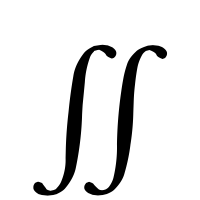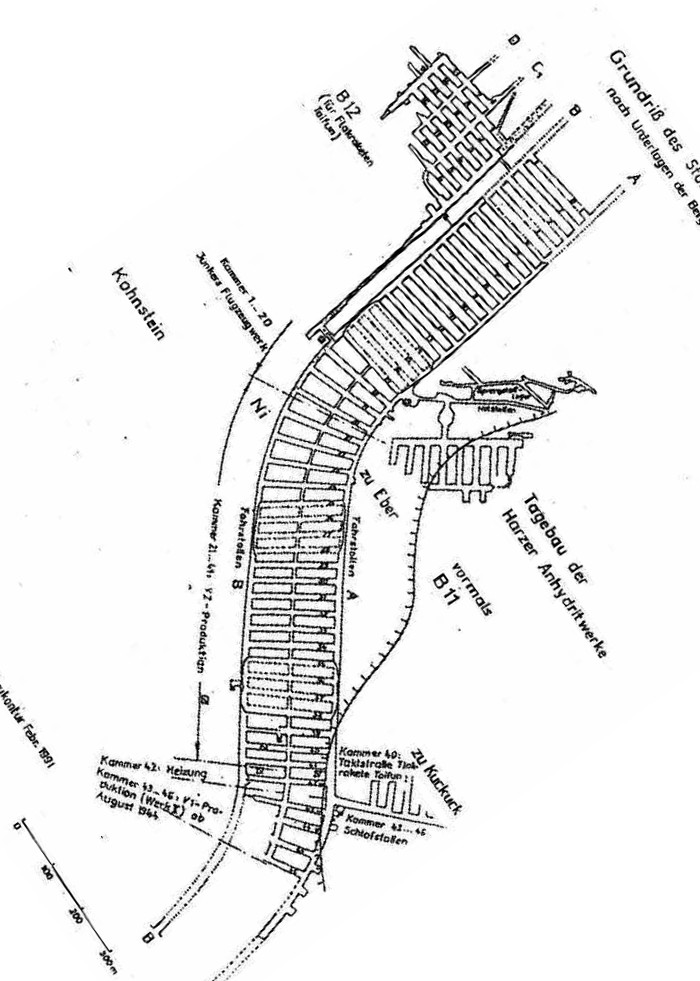A part of Gravity’s Rainbow plays in the mines of Kohnstein that were repurposed for production of the V1 and V2 rockets. Prisoners of the Nazis concentration camp Mittelbau-Dora worked there under inhumane conditions. More people died manufacturing the V2 than were killed by its deployment.
One of this section’s themes is the architecture of the place and how it relates to destruction and death. We listen in to the conversation between the master architect and one of his apprentices:
“Wait, Master, don’t light it—Master, put it out, please, it’s an exploding cigar!”
“Proceed, Hupla, with the intelligence that prompted your rather rude entrance.”
“But—”
“Hupla . . .” Puffing masterful clouds of cigar smoke.
“It-it’s about the shape of the tunnels here, Master.”
“Don’t flinch like that. I based that design on the double lightning-stroke, Hupla—the SS emblem.”
“But it’s also a double integral sign! Did you know that?”
“Ah. Yes: Summe, Summe, as Leibniz said. Well, isn’t that—”
BLAM.
Pynchon, Thomas. Gravity’s Rainbow (Classic, 20th-Century, Penguin) (S.300). Penguin Publishing Group. Kindle-Version.
To get a feel for the resemblance, take a look at the mine’s layout and the sign for a double integral:


The text then goes on with a reflection on the “meaning of the shape of the tunnels”:
In the static space of the architect, he might’ve used a double integral now and then, early in his career, to find volumes under surfaces whose equations were known—masses, moments, centers of gravity. But it’s been years since he’s had to do with anything that basic. Most of his calculating these days is with marks and pfennigs, not functions of idealistic r and θ, naïve x and y. . . . But in the dynamic space of the living Rocket, the double integral has a different meaning. To integrate here is to operate on a rate of change so that time falls away: change is stilled. . . . “Meters per second” will integrate to “meters.” The moving vehicle is frozen, in space, to become architecture, and timeless. It was never launched. It will never fall. In the guidance, this is what happened: a little pendulum was kept centered by a magnetic field. During launch, pulling gs, the pendulum would swing aft, off center. It had a coil attached to it. When the coil moved through the magnetic field, electric current flowed in the coil. As the pendulum was pushed off center by the acceleration of launch, current would flow—the more acceleration, the more flow. So the Rocket, on its own side of the flight, sensed acceleration first. Men, tracking it, sensed position or distance first. To get to distance from acceleration, the Rocket had to integrate twice—needed a moving coil, transformers, electrolytic cell, bridge of diodes, one tetrode (an extra grid to screen away capacitive coupling inside the tube), an elaborate dance of design precautions to get to what human eyes saw first of all—the distance along the flight path. There was that backward symmetry again, one that Pointsman missed, but Katje didn’t. “A life of its own,” she said. Slothrop remembers her reluctant smile, the Mediterranean afternoon, the peeling twist of a eucalyptus trunk, the same pink, in that weakening light, as the American officer’s trousers Slothrop wore once upon a time, and the acid, the pungent smell of the leaves. . . . The current, flowing in the coil, passed a Wheatstone bridge and charged up a capacitor. The charge was the time integral of the current flowing in the coil and bridge. Advanced versions of this so-called “IG” guidance integrated twice, so that the charge gathering on one side of the capacitor grew directly as the distance the Rocket had traveled. Before launch, the other side of the cell had been charged up to a level representing the distance to a particular point out in space. Brennschluss exactly here would make the Rocket go on to hit 1000 yards east of Waterloo Station. At the instant the charge (BiL) accumulating in flight equaled the preset charge (AiL) on the other side, the capacitor discharged. A switch closed, fuel cut off, burning ended. The Rocket was on its own.
Pynchon, Thomas. Gravity’s Rainbow (Classic, 20th-Century, Penguin) (S.301-302). Penguin Publishing Group. Kindle-Version.
Ok, since there was no GPS back in World War 2 the rocket needed to measure acceleration to know about the distance it travelled. Let’s do some calculations:
We will assume that the rocket always has constant acceleration that is mostly directed upwards (y), but also has some components that push forward (z) and left (x):
acceleration(t) = a(t) = (x,y,z) m/s^2 = (-1, 5, 2) m/s^2
We can now calculate the double integral of this, to get the position of the rocket at time t:
position(t) = ∫∫ a(t) dt = ∫∫ (-1, 6, 4) m/s^2 dt = ∫ (-1t, 6t, 4t) m/s dt = (-1t^2, 3t^2, 2t^2) m
Let’s say we want the rocket to reach a height of 50km = 50.000m. We can then calculate how many seconds the rocket will fly:
3t^2= 50.000 <=> t = 100 sqrt(5/3) <=> t = ~129s
So “Brennschluss” is reached after about 129 seconds.
There are another two meanings of the double S shape that Pynchon talks about. One is “the shape of lovers curled asleep” which is less interesting mathematically. The other one is this:
That is one meaning of the shape of the tunnels down here in the Mittelwerke. Another may be the ancient rune that stands for the yew tree, or Death. The double integral stood in Etzel Ölsch’s subconscious for the method of finding hidden centers, inertias unknown, as if monoliths had been left for him in the twilight, left behind by some corrupted idea of “Civilization,” in which eagles cast in concrete stand ten meters high at the corners of the stadiums where the people, a corrupted idea of “the People” are gathering, in which birds do not fly, in which imaginary centers far down inside the solid fatality of stone are thought of not as “heart,” “plexus,” “consciousness,” (the voice speaking here grows more ironic, closer to tears which are not all theatre, as the list goes on . . .) “Sanctuary,” “dream of motion,” “cyst of the eternal present,” or “Gravity’s gray eminence among the councils of the living stone.” No, as none of these, but instead a point in space, a point hung precise as the point where burning must end, never launched, never to fall. And what is the specific shape whose center of gravity is the Brennschluss Point? Don’t jump at an infinite number of possible shapes. There’s only one. It is most likely an interface between one order of things and another. There’s a Brennschluss point for every firing site. They still hang up there, all of them, a constellation waiting to have a 13th sign of the Zodiac named for it . . . but they lie so close to Earth that from many places they can’t be seen at all, and from different places inside the zone where they can be seen, they fall into completely different patterns. . . .
Pynchon, Thomas. Gravity’s Rainbow (Classic, 20th-Century, Penguin) (S.302). Penguin Publishing Group. Kindle-Version.
He poses the question “And what is the specific shape whose centre of gravity is the Brennschluss Point?” and says that there is only one shape that satisfies this criterion.
I really have no idea what specific shape he is alluding to here. Maybe it’s just his way of toying with the reader. But please let me know if you have a more satisfying solution!
Update 2022-02-21: I came up with a possible solution now.



Thank you! I’m just starting to re-learn math as an adult (I try and follow the logic at least for the complex stuff!) and am also coincidentally reading this book -finding loads of math content has been great, really changed how I think literature can be used. The book is all the better to follow and get deeper into the narrative with the math explained and I’ll certainly check out your other posts as the book progresses (and backtrack, the probability/statistics themes from prior to the double integral needs a revisit by me!)
Glad you enjoyed this blog post. And have fun with the book. It’s like math in the aspect that you always have to revisit it to appreciate all of its beauty.
This series of articles is really great! Thank your for taking the time to put them together. I’ve always wanted to check a few of these things (like the velocity of night in southern France). To your last question in this post, isn’t the shape he is referring to a rainbow? An arc “whose center of gravity is the Brennschluss Point”?
I’m glad you’re enjoying the posts.
I like your rainbow shape theory. I’ll have to take a closer look sometime if there is a way in which you can calculate the arc’s centre of gravity in a mathematically rigorous way so it turns out to be the Brennschluss Point. But I have 8 other unfinished GR posts in the work, so maybe I should finish that first. It’s really insane how much math-related stuff is in this book if you take a closer look.
The shape is the parabola
Pingback: The math behind Gravity’s Rainbow (Part8): The shape whose centre of gravity is the Brennschluss point | Niklas Riewald